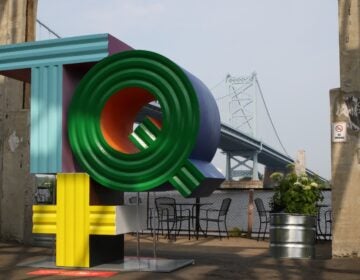‘Love and Oblivion’: An art exhibit that leans into a life with no future
The exhibition at Slought features sculpture, video, installation, painting, and performance works from several artists speaking to one person’s vision.

A series of portraits by John Carlo Dionisio depict Ashani Oblivion, a character conceived by Zay Ali and portrayed by Arien Wilkerson. (Emma Lee/WHYY)
Arien Wilkerson found love at the end of the world.
Since the COVID pandemic shut down much of society a year and a half ago, they have been on a relationship roller coaster.
“COVID happened, and the world was coming to its partial end,” they said. “I fell in love with someone, and then we made a bunch of art, and then we broke up. That sent me into this crazy spiral, questioning all of my ideas around loss and love and everything else.”

Wilkerson is no stranger to living in oblivion. As a Black, trans, queer artist, they know what it is to be marginalized by the larger society. As a 29-year-old with HIV, they have had to come to terms with the idea of their own mortality at a relatively early age, to the point where they embrace it in their art.
Wilkerson pointed to their video art called “Love Piece.”
“That piece is interesting because it features the bed that I contracted HIV on. I actually saved it and made a sculpture out of it,” said Wilkerson. “It’s this long, drawn-out idea around a monument to a moment of my life.”
“Love Piece” and several other works by Wilkerson, along with works by a handful of friends, make up “Love and Oblivion,” an exhibition at Slought, an art and social engagement space at the University of Pennsylvania.
Unlike practitioners of Afrofuturism, who often use tropes from science fiction to imagine a Black future, Wilkerson takes a page from 1970s British punk by leaning into a life with no future.

“This recurring idea around mortality has always been present in my life,” they said. “We spend most of our lives being so caught up through the demands of white supremacy and how to build a future, COVID created this idea of not having a future at all.”
“I sort of love that,” Wilkerson continued. “What if we just stopped imagining futures and just be present? What if we stopped being present and just be in the state of unawareness, be in the state of pure ecstasy?”
Wilkerson is neither a nihilist nor a pessimist. Part of “Love and Oblivion” is a display of empty prescription bottles of Biktarvy, an HIV treatment drug. The line of a dozen bottles on Slought’s windowsill represents one year of pills Wilkerson takes daily to manage their condition.
“Love and Oblivion” features sculpture, video, installation, painting, and performance works that, although coming from several artists, Wilkerson intends to speak to a very personal vision of willfully living and loving without imagining what comes next.
Some of the works are very conceptual, with abstract meaning. A pillow is left in the center of the floor by artist Kevin Hernández Rosa, who also pushed a folding table against a wall and fixed a plastic bottle above it, covered in orange plastic goop. The viewer can ponder how the works relate to Wilkerson’s theme.
Other works are more literal. A video installation by Qiaira Riley is a loop of Google map street views that the artist clicked through, showing the route from her home in Chicago to her grandmother’s house in a small town in Mississippi. Imposed over the image is a smaller video window showing the artist making a sweet potato pie from her grandmother’s recipe. The entire video is projected onto a shelf of ceramic figurines of Black characters, representing the artist’s grandmother’s collection.

Three days before “Love and Oblivion” opened, Wilkerson’s own grandmother died. Her death was not sudden, but anticipated: They said she suffered from kidney failure and decided to stop doing dialysis treatments.
“She made a deliberate choice, you know. She was also in pain,” said Wilkerson. “She really dynamically changed my future in so many ways. I think being an artist is a messy job, and we get to sort of work out these really messy ideas.”
The scope of the exhibition describes a small social group: The participating artists are either friends of Wilkerson or those of their ex-partner. To keep the focus of the show on the arc of love and loss within a global pandemic, Wilkerson only approached artists who were witness to their short-lived relationship.
Many of the artists did not make work specifically for this show, and Wilkerson said they may not even agree with its premise but allowed their work to be shown nevertheless. Their ex-partner, David, collaborated with Wilkerson on several video pieces, but was not consulted about this exhibition. Wilkerson is not even sure their ex-partner is aware of “Love and Oblivion.”
“I don’t think every artist agrees with my ideas around no future. I don’t think every artist agrees with my ideas around oblivion, or living in the state of nothingness,” they said. “But that’s still beautiful because their work is going to be living in a state of that contradiction.”

Get daily updates from WHYY News!
WHYY is your source for fact-based, in-depth journalism and information. As a nonprofit organization, we rely on financial support from readers like you. Please give today.







